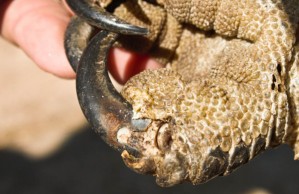ANOTHER CROWNED EAGLE LOST TO ELECTROCUTION
On 6 March, 2016 we began to get an indication that a critically endangered crowned solitary eagle carrying a satellite transmitter in Argentina may be in trouble. The transmitter was stationary and its battery level was falling. On 15 March, José Sarasola traveled 1,300 kilometers to the last coordinate near San Luis and found the bird under a power pole. The bird named “Mahuida” by the Buenos Aires Zoo had been electrocuted.
A young eagle on banding day. The solitary crowned eagle produces only a single young per year. Photo by Bart Paxton.
Mahuida is the fourth eagle included in the crowned eagle tracking project to be electrocuted in as many years. Electrocution of raptors is a global conservation problem. Birds are electrocuted either by perching on poles and touching their body parts to conductors and completing a circuit, or by flying into two lines and completing a circuit. Within open landscapes power poles offer attractive hunting or loafing perches and are used by many bird species. These same poles represent death traps when electrical suppliers do not use avian-safe practices. Avian-safe practices were developed by the power industry decades ago but have yet to be implemented in many areas. During 2012 CECARA, the Center for the Study and Conservation of Birds of Prey of Argentina (Centro para el Estudio y Conservación de las Aves Rapaces en Argentina) surveyed 3,114 power poles within a 12,000 square-kilometer area and found five dead crowned eagles. All poles associated with mortalities had “jumpers” or connecting wires above the pole crossbeam, a configuration that is not avian-safe. Such poles represented only 2% of those surveyed.
The crowned solitary eagle has an estimated global population of well below 1,000 individuals, is classified as endangered on the IUCN Red List, is included on the threatened lists of both Brazil and Argentina, and is presumed extirpated in Uruguay with no reported sightings since 1933. The species has a very low reproductive rate and so has a correspondingly low capacity to absorb mortality (read about sustainable mortality limits).
The tell-tale burn on Mahuida’s foot is a give-away sign of electrocution. Photo by José Sarasola.
Evidence is mounting that mortality factors such as electrocutions and shootings are playing a significant role in the observed declines of this charismatic species. We know how to prevent pole electrocutions. Poles that represent death traps need to be retrofitted to comply with avian-safe practices throughout the breeding range of the crowned eagle.
>>LINK<<










 Centro para el Estudio y Conservación de las Aves Rapaces en Argentina (CECARA)
Centro para el Estudio y Conservación de las Aves Rapaces en Argentina (CECARA)